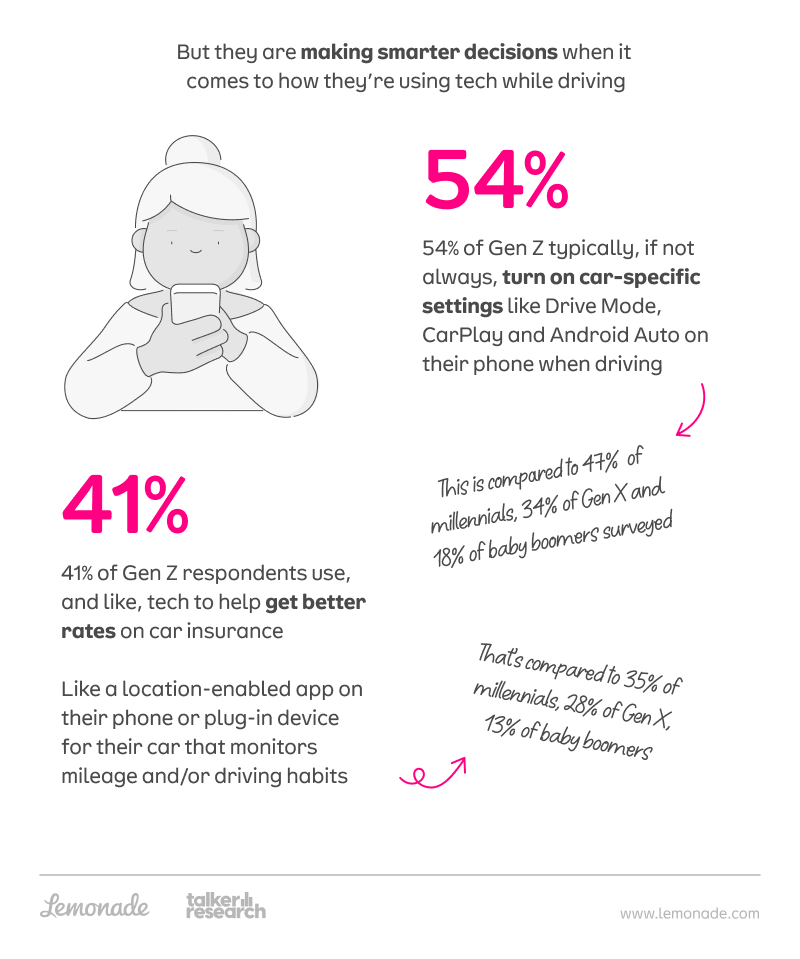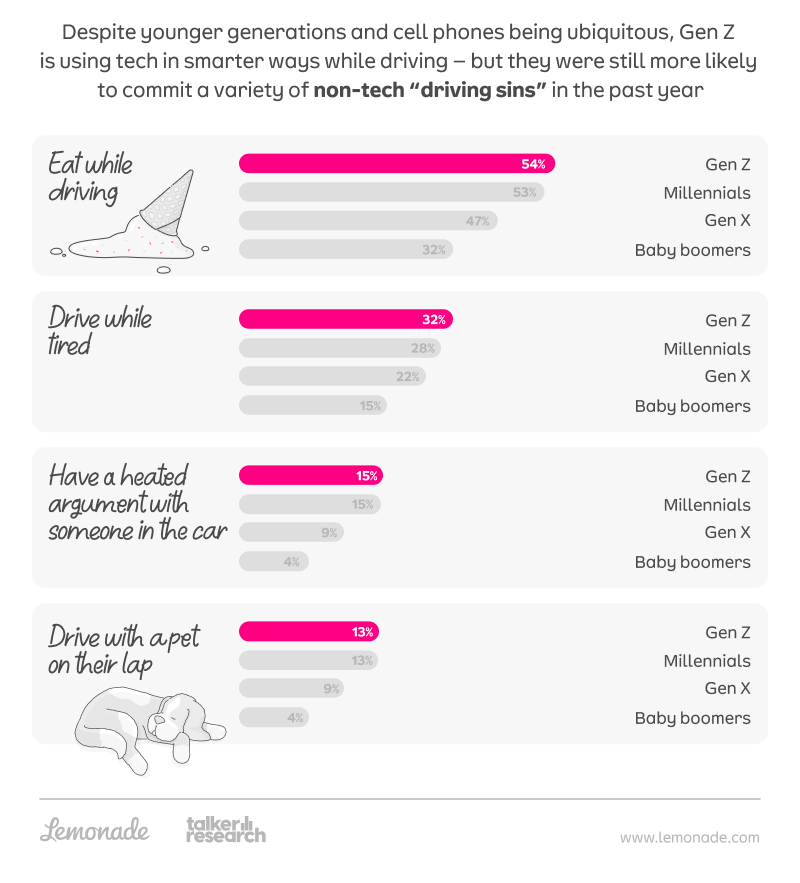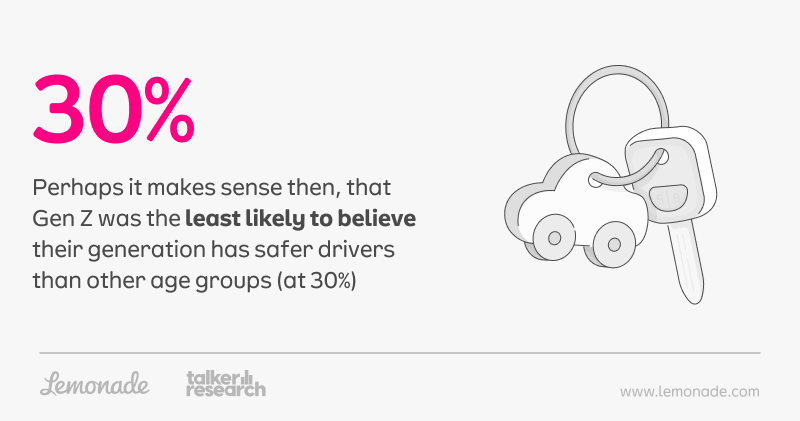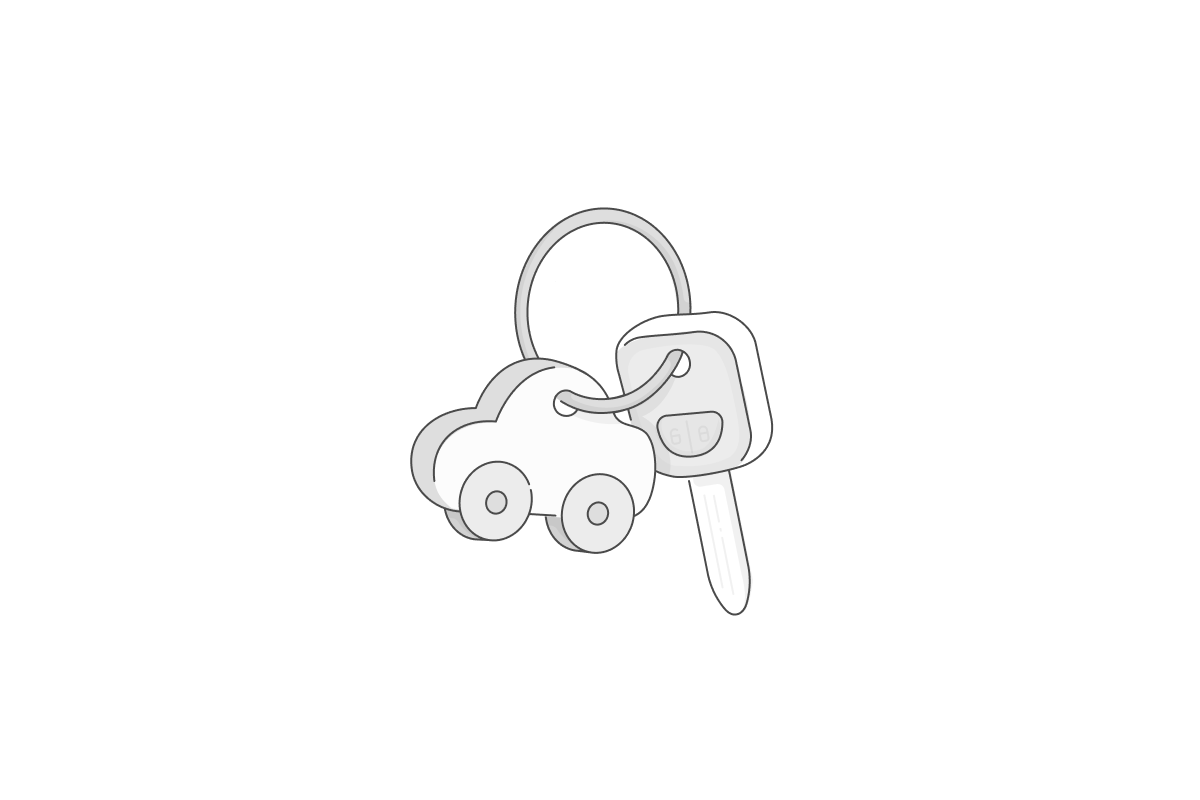When it comes to driving, Gen Z might be their own harshest critics. According to new research from Lemonade, only 30% of Gen Z believe their generation drives more safely than others.
That’s a sharp contrast to the confidence shown by other age groups. 43% of millennials, 60% of Gen X, and 63% of baby boomers gave their own peers a vote of confidence when asked the same question.
But here’s the twist: While Gen Z is quick to call themselves out, the data suggests they might be doing better than they think—especially when it comes to using tech while behind the wheel.
As part of Distracted Driving Awareness Month in April 2025, Lemonade commissioned a survey in collaboration with market research firm Talker Research, asking 2,000 American drivers—500 from each generation—how they approach driving in an increasingly connected world (more on the methodology here).
Let’s take a look at how Gen Z drivers are creating a new kind of driving culture—one that’s tech-first, and more realistic about the risks of being behind the wheel.
Gen Z are safer drivers than they realize
Despite their low confidence in their peers, Gen Z drivers drove about on par, if not slightly better than, older generations when it came to getting a speeding ticket or into a fender bender with another car during their first year of car ownership:
- 76% of Gen Z reported receiving zero speeding tickets, compared to 73% of millennials, 75% of Gen X, and 88% of baby boomers
- 78% of Gen Z reported getting into zero fender benders with another car, compared to 72% of millennials, 80% of Gen X, and 88% of baby boomers
That’s not nothing. Early driving experiences are often the messiest—and the most formative.
Navigating the digital age of driving
If Gen Z drivers are getting into fewer incidents behind the wheel in their first year on the road, it’s not because they’re unplugged from the world around them. Quite the opposite—they’re the most connected generation behind the wheel. The difference is in how they manage it.
Half of Gen Z respondents (50%) said they keep their phone in a holder—clipped to the air vents, placed in the cup holder, or mounted on the dash. That’s more than any other generation, 44% of millennials, 40% of Gen X, and just 29% of baby boomers.
But not everyone’s making perfect choices. 19% of Gen Z admitted to keeping their phone in their lap while driving—on par with millennials (18%), and more than Gen X (10%) or baby boomers (3%). Only 12% of Gen Z keep their phones completely out of reach, like in a bag or purse, trailing behind 15% of millennials, 20% of Gen X, and 27% of boomers who take that precaution.
Where phone placement may fall short, Gen Z’s actual phone usage habits tell a different story. 56% of Gen Z regularly turn on car-specific settings like Drive Mode, CarPlay, or Android Auto—compared to 47% of millennials, 34% of Gen X, and just 18% of boomers. And 32% of Gen Z say they always use these features, while 63% of boomers say they never do.

So how is Gen Z actually using their phones while driving?
- 64% use their phones to play music—compared to 52% of millennials, 32% of Gen X, and only 8% of baby boomers
- 54% use their phones for directions—slightly ahead of 48% of millennials, 47% of Gen X, and 37% of boomers
- Gen Z and millennials were more likely than older generations to make hands-free calls, send voice-to-text messages, and have their phone read incoming texts aloud
Gen Z isn’t immune to distraction—but they’re clearly making an effort to manage it with the tools available to them, and they’re also the most likely to embrace tech that promotes safer driving.
That same openness to technology extends beyond the steering wheel. When it comes to car insurance, 41% of Gen Z drivers said they use tech—like a location-enabled app on their phone or plug-in device for their car that monitors mileage and/or driving habits—to help get better rates and actually like it, more than any other group. That’s compared to 35% of millennials, 28% of Gen X, and just 13% of baby boomers.
“Younger drivers are redefining what it means to be responsible on the road,” stated Sean Burgess, Chief Claims Officer at Lemonade. “They’re not just open to tech-enabled insurance—they expect it. From using telematics to unlock better rates to embracing connected features that promote safer driving, Gen Z is showing that modern insurance should meet them where they are: Mobile, mindful, and data-driven.”
Gen Z is taking a slower start to driving and car ownership
Not everyone hits the road the moment they turn 16—and that’s especially true for Gen Z.
Across all respondents, the average age for getting a driver’s license was 18.4 years old. But there’s a clear generational shift when you break it down. Nearly half of baby boomers (49%) earned their license at 16 or earlier, while only 25% of Gen Z did the same. For Gen X and millennials, that figure sat at 39% and 28%, respectively.
For those who did get licensed before 18, the motivations were telling. 38% of Gen Z said they got their license early because they needed to drive to school or work—much higher than boomers, who were less likely to cite either reason (19% and 23%, respectively).
And once they got to the DMV, the path to licensure wasn’t always smooth. While 81% of baby boomers passed their driver’s test on the first try, only 63% of Gen Z and millennials could say the same. Nearly a third (30%) of younger drivers had to take the test twice.
Car ownership follows a similar pattern. On average, respondents said they got their first car at 19.6 years old. But again, who paid for that first car varied widely across generations:
- 37% of Gen Z said their car was a gift from their parents, compared to 33% of millennials, 30% of Gen X, and just 21% of baby boomers
- Only 25% of Gen Z purchased their car on their own, baby boomers were far more likely to buy their first car themselves (39%)
The difference in financial independence carries over to insurance, too.
Respondents reported switching off their parents’ insurance plans at an average age of 21.6. But 23% of Gen Z said they remain on a parent’s car insurance plan today—more than triple the rate of millennials (7%).
And while 15% of all respondents said they began paying for their own car insurance before the age of 18, only 12% of Gen Z and millennials had done so—compared to 17% of Gen X and 19% of baby boomers.
And when it comes to car costs, Gen Z drivers know the struggle. More than half (58%) said their first car was more expensive than expected, compared to 40% of baby boomers.
Differences in car usage between generations
While plenty of young drivers are licensed and on the road, their relationship with driving looks different.
Only 53% of Gen Z drivers said they drive every day—on par with Gen X, just behind millennials (58%), and well ahead of baby boomers (33%).
The main reasons for driving across all generations included running errands (59%), visiting friends or family (36%), and commuting to and from work (32%). But how each group uses their car varies.
Gen Z drivers are less likely to use their cars for errands (48%) compared to boomers (77%), and more likely to use them for commuting to work (42%)—nearly three times more than baby boomers (15%). For Gen Z, driving seems to be more about utility than habit. And while that may reflect shifting generational values, it could also come down to the stage of life—many Gen Zers are still in school, living in urban areas, or just beginning their careers, making convenience and necessity the main drivers behind when and why they hit the road.
When not driving, most respondents opt to get around by walking (45%) or getting rides from family (35%). But Gen Z stood out with a broader mix of transportation alternatives, leaning on options that are social, app-based, or shared:
- 31% of Gen Z get rides from friends, compared to 24% of millennials and 19% of both Gen X and baby boomers
- 26% use rideshare apps or taxis, compared to 21% of millennials, 18% of Gen X, and just 8% of boomers
- 18% carpool with others, compared to 14% of millennials, 6% of Gen X, and only 1% of baby boomers
While 46% of Gen Z respondents who got their license at 18 years old or earlier wanted to have the freedom that came with driving, more than the other generation, freedom looks like options for young drivers—and they’re using all of them.
Gen Z drivers are still finding their footing

Even though they’re doing about the same as most, if not better, in their first year on the road, Gen Z driving skills still have room for improvement. The survey revealed that Gen Z respondents led nearly every age group in risky or distracted driving behaviors. But that may have less to do with generational habits and more to do with experience—after all, Gen Z includes many of the newest drivers on the road, still building the muscle memory and confidence that often comes with time behind the wheel.
More than half (54%) said they’ve eaten while driving, compared to 53% of millennials, 47% of Gen X, and just 32% of baby boomers.
Drowsy driving was another standout—32% of Gen Z said they’ve driven while tired or drowsy. By comparison, 28% of millennials, 22% of Gen X, and only 15% of boomers reported the same.
And when it comes to emotional distractions, Gen Z topped the list again—17% said they’ve had a heated argument over the phone while driving, and another 15% said they’ve argued with someone in the car. Baby boomers were far less likely to report these situations—just 2% had a phone argument and 4% argued with someone in the car.
Even pet-related distractions came into play—13% of both Gen Z and millennials said they’ve driven with a pet on their lap, compared to 9% of Gen X and only 4% of baby boomers.
These numbers reveal a generation that hasn’t quite locked in the safe driving habits older generations have had more time to build.
“Regardless of how often Americans are driving, staying focused behind the wheel is one of the most important things any driver can do—for their own safety and everyone else’s,” added Burgess. “We all get tempted by distractions, but it’s clear younger drivers who were raised with technology at their fingertips are navigating that with growing awareness.”

A new kind of car insurance
Gen Z may still be building confidence behind the wheel, but the data shows they’re already making thoughtful, tech-forward choices—both in how they drive and how they manage the costs that come with it.
That’s where Lemonade Car comes in, a new kind of car insurance built to meet the needs of today’s drivers. Using the power of tech, Lemonade rewards safe, low-mileage driving with better rates—and gives drivers more control through a seamless, app-based experience.
Methodology
Talker Research surveyed 2,000 American drivers split evenly by generation; the survey was commissioned by Lemonade and administered and conducted online by Talker Research between March 18–25, 2025.
We are sourcing from a non-probability frame and the two main sources we use are:
- Traditional online access panels — where respondents opt-in to take part in online market research for an incentive
- Programmatic — where respondents are online and are given the option to take part in a survey to receive a virtual incentive usually related to the online activity they are engaging in
Those who did not fit the specified sample were terminated from the survey. As the survey is fielded, dynamic online sampling is used, adjusting targeting to achieve the quotas specified as part of the sampling plan.
Regardless of which sources a respondent came from, they were directed to an Online Survey, where the survey was conducted in English; a link to the questionnaire can be shared upon request. Respondents were awarded points for completing the survey. These points have a small cash-equivalent monetary value.
Cells are only reported on for analysis if they have a minimum of 80 respondents, and statistical significance is calculated at the 95% level. Data is not weighted, but quotas and other parameters are put in place to reach the desired sample.
Interviews are excluded from the final analysis if they failed quality-checking measures. This includes:
- Speeders: Respondents who complete the survey in a time that is quicker than one-third of the median length of interview are disqualified as speeders
- Open ends: All verbatim responses (full open-ended questions as well as other please specify options) are checked for inappropriate or irrelevant text
- Bots: Captcha is enabled on surveys, which allows the research team to identify and disqualify bots
- Duplicates: Survey software has “deduping” based on digital fingerprinting, which ensures nobody is allowed to take the survey more than once
It is worth noting that this survey was only available to individuals with internet access, and the results may not be generalizable to those without internet access.
A few quick words, because we <3 our lawyers: This post is general in nature, and any statement in it doesn’t alter the terms, conditions, exclusions, or limitations of policies issued by Lemonade, which differ according to your state of residence. You’re encouraged to discuss your specific circumstances with your own professional advisors. The purpose of this post is merely to provide you with info and insights you can use to make such discussions more productive! Naturally, all comments by, or references to, third parties represent their own views, and Lemonade assumes no responsibility for them. Coverage and discounts may not be available in all states.




